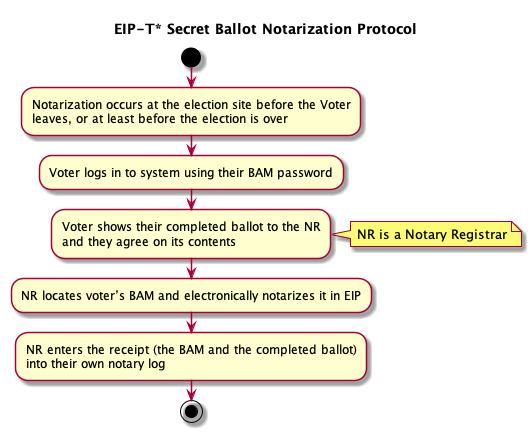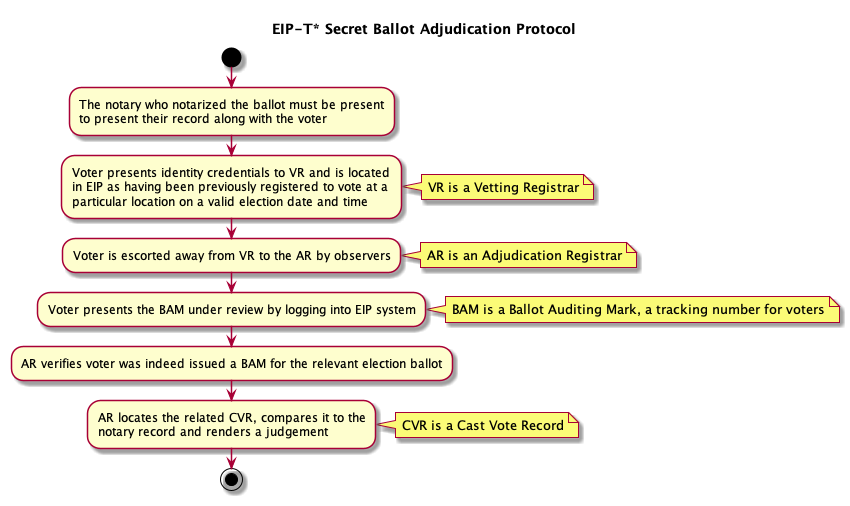Adjudication is the process of either approving or denying a remedy. In the case of an election, it is the process of correcting a faulty ballot, or refusing to if no adequate evidence is provided for a challenged result. No vote remedy is allowed without first notarizing the associated completed ballot.
Ballot Notarization
Usually a notary is a witness to the fact that a person signed a particular document. In the typical case, they take down the identity of the person, and they witness them sign a document. In the EIP use case for a secret ballot election, the notary doesn’t record the identity of the person (even if they know their identity). Instead, the parties involved are witnessing to the fact that a particular token or vote tracking number is associated with a particular set of choices on a completed ballot. The notary is basically witnessing the content of the ballot and the person who owns the ballot, whoever they are, are agreeing to those contents without revealing their identity. The notary is notarizing a completed ballot.
The basic idea here is to provide 3rd party testimony that a vetted voter voted in a particular manner without identifying them. It’s a 3rd party witness of a completed ballot for a specific VTN on a marked ballot. The notary is testifying that the person holding the token at the time of the notarization was physically present at the facility, was a vetted voter, they were issued a token / VTN and finally that they voted in the manner they present. The notary is saying that the token says what it says at the time of the vote and they have a copy to prove it. The voting persons identity is never recorded. Multiple other observers witness this transaction and may be recored as witnesses.
Offering Vote Remedy
Note that the only way a vote remedy process can be initiated is if the voter had their VTN notarized before the election is over. It should be noted that discrepancies are a near impossibility since the voter verified their ballot twice when they voted. Nevertheless, EIP offers this service as a grievance mechanism to provide a complete and thorough voting experience. Further, it may be required in elections that allow widespread anonymous voting. In practice, remedy will rarely be granted.
Notarization is optional and only necessary in the case where a voter wishes to reserve the right to challenge how their ballot was recorded. This happens when a voter believes there is a discrepancy between how they claim they voted and the way it showed up on the CVR list. Even though it is optional, it is a best practice to obtain a vote notarization.
The only way remedy is allowed is if the notary and the voter agree that the contents don’t match. This can only happen if the notary recorded the entire completed ballot at the time of notarization and also checked it against the current CVR list to make sure they matched to provide evidence during adjudication. The only way a voter can prove a discrepancy when they come back is to have them login to their ballot record with their token using their password. Could they have given this password to somebody else? Or could it have been “stolen” under duress? Yes. Those are two possibilities but the likelihood of either of them is extremely small, and would not likely affect the outcome of the election.
So here are the steps to notarize an EP electronic ballot:

The process is identical using a paper ballot except that it is manual and paper-oriented.
Seeking Vote Remedy
Here are the steps to validate the notarization when the vote is being adjudicated by a Vetting Registrar (VR) and an Adjudication Registrar (AR)
